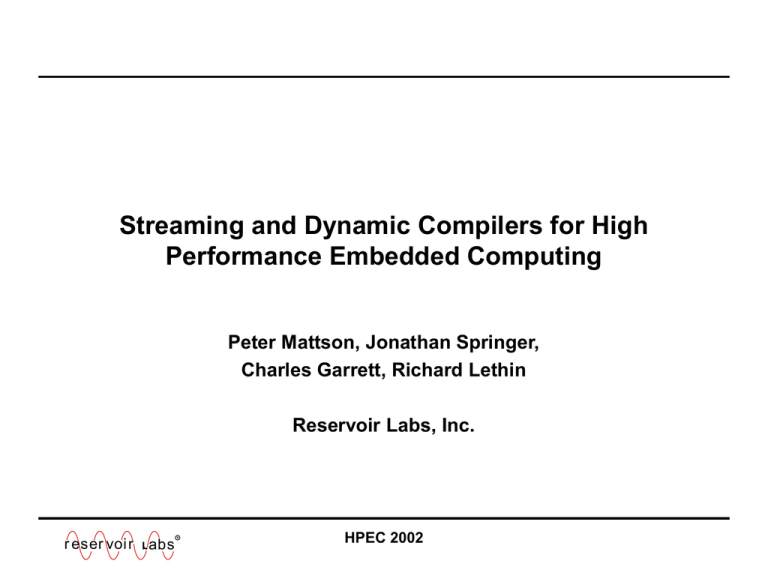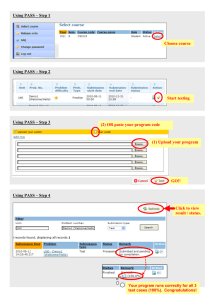Streaming and Dynamic Compilers for High Performance Embedded Computing
advertisement

Streaming and Dynamic Compilers for High
Performance Embedded Computing
Peter Mattson, Jonathan Springer,
Charles Garrett, Richard Lethin
Reservoir Labs, Inc.
r eser voi r
abs
HPEC 2002
Outline
•
Streaming Languages for HPEC / Polymorphic Computer Architectures
(PCA).
–
–
–
–
•
Mapping challenges
R-Stream™ compiler for StreamC and KernelC
Streaming Language Design Choices
Thoughts on Mapping
Dynamic Compilation
–
–
–
–
–
PCA objectives that dynamic compilation helps meet
Runtime Compilation Issues/Technologies
Example of How Dynamic Compilation Helps with Component Selection
Insertion of New Code into Running Systems
Approaches for using Dynamic Compilation Reliably
r eser voi r
abs
HPEC 2002
Polymorphic (PCA) Architectures
High arithmetic/memory ratio
IMAGINE (Stanford: Rixner et. al., 1998)
ALU Cluster
SDRAM
ALU Cluster
Less control logic
SIMD
Control
Stream
Register
File
SDRAM
SDRAM
Synchrony
Programmable
ALU Cluster
SDRAM
Parallelism
Exposed resources
ALU Cluster
ALU Cluster
ALU Cluster
Programming and Mapping
Challenge
Other Examples: RAW (MIT), VIRAM (Berkeley), Smart Memories (Stanford)
r eser voi r
abs
HPEC 2002
Imagine Performance (Dally et. al 2002)
Arithmetic Bandwidth
Application Performance
Applications
Stereo Depth Extraction
11.92 GOPS (16-bit)
320x240 8-bit gray scale
MPEG-2 Encoding
15.35 GOPS (16- and 8-bit)
320x288 24-bit color at 287 fps
QR Decomposition
10.46 GFLOPS
192x92 matrix decompositions
in 1.44 ms
Polygon Rendering
5.91 GOPS (fp and integer)
35.6 fps for 720x720 “ADVS”
benchmark
Polygon Rendering with RealTime Shading Language
4.64 GOPS (fp and integer)
16.3M pixels/second
11.1M vertices/second
Discrete Cosine Transformation
22.6 GOPS (16-bit)
34.8 ns per 8x8 block (16-bit)
7x7 Convolution
25.6 GOPS (16-bit)
1.5us per row of 320 16-bit
pixels
FFT
6.9 GFLOPs
7.4 us per 1,024-point floating
point complex FFT
Kernels
(6 ALUs * 8 PES * 400 MHz = 19.2 GOPS (peak), 0.18um, 2.56cm^2,)
r eser voi r
abs
HPEC 2002
Compiler Mapping Challenges
Resources
Parallel functional units
Parallel tiles
Distributed memories
Local bypass wires
Inter-tile wires
Mapping Requirements
Identify Parallelism
Partition Program
Select Operators
Place data
Layout data
Place computation
Schedule computation
Constraints
Functional unit availability
Distributed register files
Small bounded memories
Small or no queues
Partial interconnect
Increasing the arithmetic/memory ratio while holding silicon area fixed
simultaneously increases resources and tightens constraints.
Automatic compilation MUCH harder
Place some burden on programmer and invest in compilers
Introduce new languages to assist programmer
r eser voi r
abs
HPEC 2002
KernelC / StreamC Languages (Stanford: Mattson 2001)
KernelC Example
StreamC Example
kernel SAXPY(
istream<float> x_s,
istream<float> y_s,
ostream<float> result_s,
float a)
{
loop_stream(x_s) {
float x, y, result;
x_s >> x;
y_s >> y;
result = a * x + y;
result_s << result;
}
}
streamprog testSAXPY (String args) {
const int testSize = 128;
stream<float> x_s(testSize);
stream<float> y_s(testSize);
stream<float> result_s(testSize * 2);
stream<float> evenResult_s =
result_s(0, testSize, STRIDE, 2);
stream<float> oddResult_s =
result_s(1, testSize, STRIDE, 2);
// initialize x_s and y_s
...
// compute
SAXPY(x_s, y_s, evenResult_s, 3.4);
SAXPY(x_s, y_s, oddResult_s, 6.7);
...
}
Make High Level Dataflow and Low Level Parallelism Explicit
r eser voi r
abs
HPEC 2002
R-Stream™: Compiling KernelC and StreamC
Compiling KernelC
•Replicate kernel across clusters
for SIMD control.
•Generate conditional stream IO
operations for data-driven dynamic
behavior.
•Modulo-schedule the kernel to get
a tight loop.
•Explicitly manage communication
resource.
Compiling StreamC
•Inline/flatten program into Kernel
call sequence.
•Constant propagate so strip size is
explicit.
•Allocate Stream Register File (Local
Memory) with a Process like Register
Allocation.
Output is C++ program for
Imagine controller, that
generates stream initiators and
synchronization calls.
Output is Imagine SIMD
control program.
R-Stream™ can address the mapping challenge
posed by these new architectures.
r eser voi r
abs
HPEC 2002
StreamC and KernelC Language: Observations
•
Emphasis is on letting programmer express partitioning and parallelism.
KernelC is like a new assembly language (e.g., modulo scheduling now moves
to the assembler.) The major development challenges for compilation –
determining partitioning and mapping - are at the level of the StreamC
compiler.
•
Nevertheless, there is interaction between StreamC and KernelC compilers
which leads to some hand-holding by the programmer of the compiler. Some
of this is due to architectural problems (e.g., spilling scratch registers) and
some is unavoidable phase interaction. Should they be fused?
•
C++ syntax: with special templates and libraries can be compiled by a generic
C++ (e.g., Microsoft Visual C++) compiler for code development.
•
Expression of conditional stream IO operations allows data-dependent data
motion, and maps directly to special hardware on Imagine or can be
synthesized with software operations (Kapasi et. al. 2000).
r eser voi r
abs
HPEC 2002
Streaming Language Design Choices
Imperative (e.g. StreamC, Brook [Stanford])
kernel1(…, streamB);
kernel2(streamB, …);
Easy to represent state, control-flow, finite streams
Good for describing array-based algorithms (stride)
Probably map well to conventional DSP
The history of streaming
languages is long.
These programs could be
transformed, easily, into
FORTRAN
Challenge is how to map!
This gets much harder
with dynamic behavior.
Dataflow (e.g. StreamIt [MIT], Streams-C [LANL])
kernel1.output1.connect(streamB);
kernel2.input1.connect(streamB);
go();
Easy to represent task parallelism, infinite streams
Good for describing continuously-running systems
r eser voi r
abs
HPEC 2002
There are other things we
might need to express,
(e.g., flexibility in ordering
semantics, periodic
invocation,) which arise
from nature of embedded
systems (Lee 2002)
Thoughts on Mapping
•
Key technologies for compilation for PCA:
– Optimizations that incorporate constraints of small bounded memories.
– Optimizations that incorporate communications bandwidth constraints.
– Optimizations that incorporate non-traditional objectives (e.g., latency,
power).
•
Probably:
– Will see increasing fusion of compiler phases to allow fine-grained
tradeoffs between parallelism and storage use.
– More and more, see compilation implemented as search/solvers over
constraint systems.
– New program intermediate representations forms, such as Array-SSA
(Knobe 1998) or PDG will invigorate development of these key
technologies.
r eser voi r
abs
HPEC 2002
Handling Dynamic Behavior Looks Difficult
Dynamic Behaviors
•Data-dependent iteration counts,
strides, access patterns.
•Conditionals within loops.
•Task parallelism.
•External dynamic conditions:
mission changes, problem
arrival, etc.
•Resource changes (hardware
failures).
•Changes to application (e.g.,
dynamic component
replacement).
•Morphing.
Characterize by:
Size of change
Time constant of change
Space of configurations
r eser voi r
abs
Use existing technologies and tricks
for parallel dynamic load balancing,
throttling, mapping, scheduling …
But with the additional challenge of
greater degrees of parallelism and
more severe resource constraints.
If finding a static mapping for
PCA hardware is so hard, how
can we expect to achieve the
same result with an online,
distributed, and low-overhead
mapper?
HPEC 2002
Dynamic Compilation: Can it Apply to HPEC?
PCA Technology Program Objective
Subset
Dynamic Compilation Capabilities
(as demonstrated by R-JIT™ for Java)
Hardware unknown until mission (e.g.,
failures, other resident apps).
Optimization at mission initiation.
Mission parameters (#targets, etc.)
unknown until runtime.
Runtime profiling and profile-driven
optimization.
Runtime assembly and selection of
library components.
Cross-module optimization at runtime
simultaneously with class loading.
Desire for a morphware “virtual
machine”
Java virtual machine.
Changing mission parameters,
objectives, and system resources at
runtime.
Runtime recompilation and insertion of
new code into running systems.
r eser voi r
abs
HPEC 2002
Runtime Compilation Issues / Technologies
•
How can a compiler be made fast & resource-efficient enough to work
effectively at runtime?
– Efficient data-structures and IR.
– Integrated optimizations: do multiple mapping and optimization tasks in
the same phase, limit phase iterations.
– Apply optimization selectively to high-priority sections.
– Sequence from light to heavy optimization based on priority.
•
Nevertheless, heavy parallelism and constraint nature of PCA
architectures presents a new level of compilation challenge to perform
at runtime.
– Optimizing application might take hours or more (e.g., solving complex
constraint system using integer programming).
– We can start by apply the Java strategies to these new compiler problems
• E.g., achieve variation in optimization intensity for modulo scheduling by
searching first for schedules in looser initiation intervals.
– New approaches
• E.g., pre-analyzed or partially compiled code “finished” at runtime.
r eser voi r
abs
HPEC 2002
Dynamic Component Selection: Two Possible Approaches
Component Assemblies
•Collections of precompiled
components (different
problem sizes, algorithms).
•Decorated with metainformation (XML) or
selection control scripts.
•Loader mediates metainformation and constraints
to select component.
Object-Oriented Approach (Java/CLOS)
•Component selection is handler selection.
•Loader and compiler tightly integrated.
•Express meta-information within the
application in the application language.
•Static conditions at call site inferred from
program context.
•Dynamic conditions at call site handled
using runtime code generation (e.g., profilemotivated speculation and generation of callsite predicates).
•Expression within programming language
allows seamless inter-module analysis and
optimization.
The object-oriented and dynamic compilation
approach has structured and tested ways of
handling this. Advantages in engineering
economy, simplicity, and reliability.
r eser voi r
abs
HPEC 2002
Insertion of New Code into Running Systems
•
The challenge of dynamic class loading in Java, and how to
implement:
– Class hierarchy in a Java application is not static.
– For competitive performance, JIT must perform inter-module optimizations
using the speculation that class hierarchy is static.
– The action of a dynamic class load invalidates that speculation.
– How to transform in-progress invocations (thread queue, call stack?)
• How do we transfer PC?
• How do we transform optimized state?
– One approach (Sun’s Hotspot) is dynamic decompilation facility.
• Hairy, slow, complex semantics. How to validate?
– Reservoir’s approach: pseudo-conditionals and simple code-rewriting.
•
These technologies can apply to PCA
– To “morph” to pre-compiled configurations over small mission sets.
– To generate “sockets” for morphs to runtime generated configurations for
large or open mission sets.
r eser voi r
abs
HPEC 2002
Reliability of Dynamic Compilation
Concerns about reliability are
justifiable:
•The complexity of
dynamic compiler
transformations exceed
the complexity of modern
dynamic instruction issue
hardware.
•In practice, Reservoir has
found that other leading
commercial release JVMs
fail to pass our random
Java test suite (R-JVV™).
Reservoir’s Approach to Dynamic
Compilation Testing
•Intense application of randomly generated
tests.
•IR maintenance of extra information to
detect optimization failures, with graceful
recovery.
•Coverage analysis increases proportion of
compiler that is exercised.
•Limit deployment to a single application.
Reservoir’s mainframe system R-DYN™
deployment with only one bug found in 4
years (Bank 2001)
Still, much R&D required specifically in compiler validation:
e.g., Model-driven testing, compiler specification checking, proofcarrying code.
r eser voi r
abs
HPEC 2002
Summary
•
New programmable DSP architectures can achieve performance near
fixed function hardware (e.g. Imagine, 20 GOPS).
•
... but introduce major compiler challenges!
•
New streaming languages can help.
•
Automated mapping for multiple cores/distributed memories is critical
research area.
•
Advancing automatic mapping technology for dynamic compilation
has the potential to solve other important problems.
r eser voi r
abs
HPEC 2002
References
•
•
•
•
•
•
•
Bank et. al. 2001 “Dynamic Optimization in the Mainframe World”
FDDO-4.
Dally et. al. 2002: Stanford’s Imagine Web Site:
http://cva.stanford.edu/imagine/project/im_perf.html
Kapasi et. al. 2000 “Efficient Conditional Operations for Data-parallel
Architectures” MICRO-33.
Knobe, Sarkar 1998 “Array SSA form and its use in Parallelization”,
SOSP.
Lee 2002 “Embedded Software” To appear in Advances in Computers
(M. Zelkowitz, editor), Vol. 56, Academic Press, London.
Mattson 2001 “A Programming System for the Imagine Media
Processor” Stanford Ph.D. Thesis.
Rixner et. al. 1998 “A Bandwidth-Efficient Architecture for Media
Processing” ISCA-31.
© 2002 Reservoir Labs, Inc.
r eser voi r
abs
HPEC 2002


